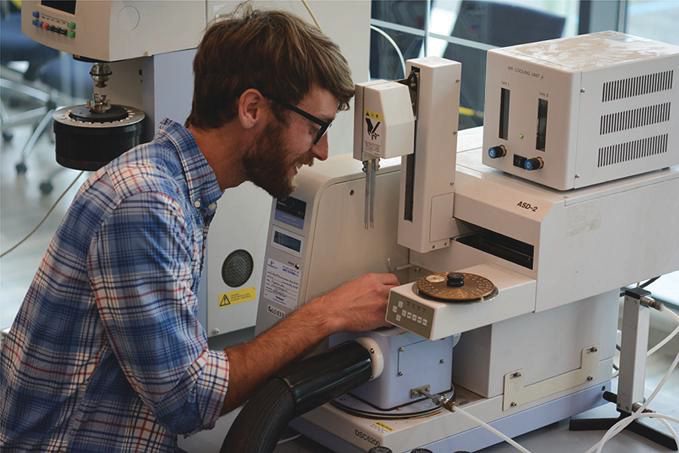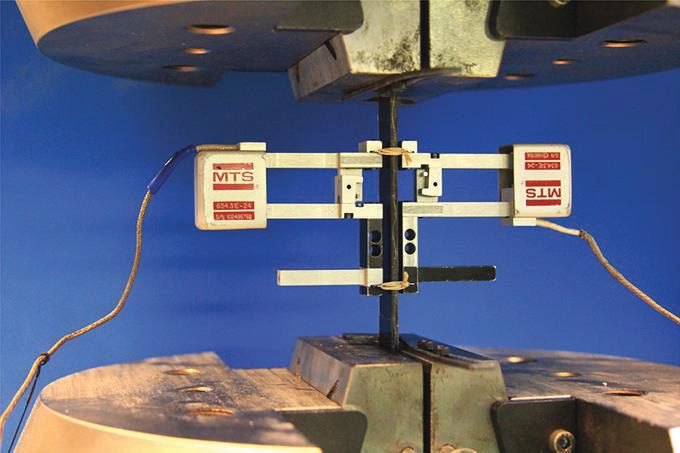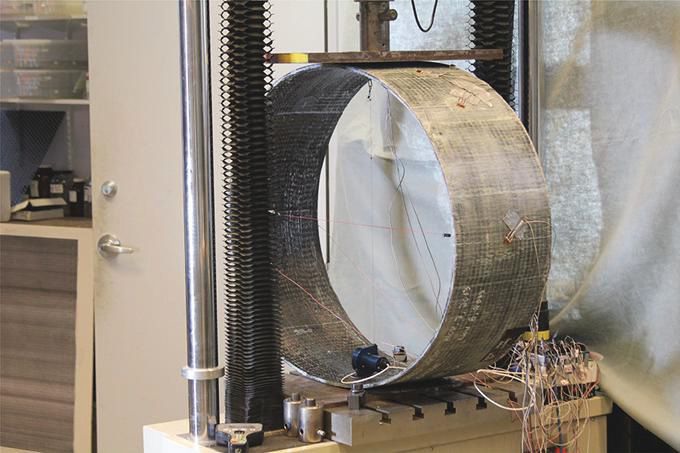CFRP Pipe Repair: How To Ensure Success
By Casey A. Sturrup and Brian J. Toney
Lining damaged pipes with carbon fiber reinforced polymer (CFRP) can be an efficient and reliable fix, but one that can go awry without quality assurance and control.
Numerous articles have been written describing the condition of existing infrastructure and the importance of maintaining critical services during our current times (Antoniewicz and Radzinski). A major segment of infrastructure is piping. Piping concerns exist for many industries (e.g., drinking water, wastewater, power generation) and keeping water moving is critical for not only emergency services but for maintaining the flow of life for all. Downtime for repairs and replacements of piping is expensive, disruptive, and time-consuming. One technology being used in the piping industry is lining existing pipes with carbon fiber reinforced polymer (CFRP).
Pipe lining is a well-established process with many references available explaining the materials and techniques used. What is not as well-known are the quality control measures required to ensure a successful installation. All the planned advantages of pipe lining (e.g., less excavation, shortened time out of service, less disruption to above-ground operations) can quickly evaporate if the work is not performed correctly. Accurate quality assurance/quality control (QA/QC) allows for greater engineering certainty and faster pipe reopening.
CFRP Lining Technology
U.S. universities began researching the use of CFRP for civil and structural applications in the late 1980s. The next decade saw CFRP gain acceptance for the strengthening of building components within the engineering and construction industries. CFRP was first used for the strengthening of large-diameter underground prestressed concrete cylinder pipe (PCCP) in the late 1990s. By the early 2000s, various municipal utilities began experimental use of CFRP lining for degraded PCCP; and by 2009, several utilities had begun to issue contracts for installation of CFRP liners for renewal projects (Zarghamee).

Table 1. CFRP Attributes
Utilities then sought a consensus standard for the design and installation of CFRP renewal and strengthening of their PCCP lines. In response, the American Water Works Association (AWWA) approved the development of a standard (AWWA C305) and assigned the responsibility to the AWWA Standards Committee on Concrete Pressure Pipe (Zarghamee).
There are many advantages to the repairing and/or strengthening of existing piping with CFRP. See Table 1 for a listing of CFRP attributes.
For information on the design and installation of CFRP, please see AWWA, Zarghamee 2019, Zarghamee 2017, Zarghamee 2013, and Zarghamee 2016.
QA/QC
CFRP linings are used in cracked, damaged, or leaking prestressed concrete pipes to act as a “pipe within a pipe” to extend the life span of the existing pipe and to get it back in service without extensive downtime or cost. Because of the varying design requirements, engineers work closely with clients to determine the properties of the material when being applied in either new lay-ups/configurations or existing tried-and-true systems. Lay-up configuration can vary by the number of plies, weave direction, and/or inclusion of a bidirectional glass fiber reinforcement.
For every section of pipe that is repaired, there is a suite of tests that must be completed to ensure that the installed product meets the design requirements before being put into service, with the tests falling into two categories — chemical testing and physical testing — both of which are required to fully understand the as-installed materials. As further described below, chemical testing is performed on samples of the installed material mainly to investigate the degree of cure, while physical testing is performed in the field and laboratory on the as-installed materials and on field-prepared witness samples.
Chemical Testing
Two-part structural epoxies are shipped to the construction site as two separate liquid components: Part A (resin) and Part B (hardener). Once mixed, the parts react to form a solid epoxy polymer. Because of this, the degree of reaction (or “cure”) is of primary importance because it relates directly to mechanical strength and performance of the installed system. Because the degree of curing testing can be correlated with physical properties, and because it can be performed with much less cost and disruption than physical testing, it is often used as a primary QA/QC measure once correlated to physical testing results.
Every time a molecule of Part A and Part B reacts, they release a certain amount of heat. Therefore, the degree of cure can be determined by measuring the heat released by a partially cured sample while it is forced to fully cure. This can be accomplished using a differential scanning calorimeter (DSC). A DSC has a calibrated furnace capable of heating a sample (forcing full cure), while also measuring the sample’s heat output. ASTM E2160 describes the method for determining degree of cure of an epoxy using DSC.

Loading a sample into a DSC
Glass transition temperature is another important property of epoxy that should be considered. A rubber ball will bounce at room temperature but is brittle and will shatter if cold enough. There is a small temperature range at which the ball goes from bouncy to brittle. That temperature is defined as the glass transition temperature (Tg). This is different from freezing, as the rubber doesn’t go from a liquid to a solid but instead from a rubbery solid to a brittle solid.
Epoxy and other polymers behave in a similar manner, except these materials are intended to operate as a rigid solid (below the Tg). As an epoxy cures, the glass transition temperature increases, meaning it becomes a rigid solid at higher temperatures. The epoxy cure reaction slows dramatically once the epoxy transitions from a rubber to a brittle solid. Therefore, the epoxy will cure until the glass transition temperature reaches that of its environment and then slows severely. As a result, if a CFRP liner is cured at 80°F but put into service at 100°F, the epoxy may temporarily soften. Because of this, pipe liner epoxies should be cured until the glass transition temperature is above the operating temperature. ASTM E2160 describes a method for determining the glass transition temperature of epoxies using DSC.
Physical Testing
Physical testing is performed in the field on the as-installed CFRP and on test/witness panels made in the field with the material installed in the pipe so that the panels are a true representation of the carbon fiber material and epoxy used in the system. The relevant properties tested include, but aren’t limited to, tensile, shear, flexure, and adhesion.
It is necessary that physical testing be completed in parallel with chemical testing for correlation to the DSC testing. Not only does the degree of cure need to be determined, but physical testing is needed to determine if the liner is in fact strong enough to be put into service. To determine strength, destructive physical testing on components of the CFRP lay-up and the assembled system must be completed. Physical testing is performed utilizing universal testing machines equipped with sensors and data acquisition software, as well as custom-made fixtures to test assemblies.

ASTM D3039 tensile test with extensometers
The physical testing performed to ensure high quality of the installed pipe includes tensile testing of the witness panels to determine the carbon fiber material’s ultimate strength and modulus of elasticity following ASTM D3039. Sectioned pieces of the witness panel are gripped in a universal tester and pulled until failure, with extensometers recording strain data. Multilayer tension tests are also performed to determine how tensile properties are affected with additional layers.
To be sure that the pipe lining will not debond from the substrate, pull-off/adhesion testing per ASTM D4541 must also be performed. To test the bond strength, a small test dolly is applied to the surface and then pulled off while measuring the force required to do so. These tests can be performed in the field while the lining is being installed (and then patched), as well as conducted in the laboratory to verify lay-up or to trial new lay-ups.
Single- or double-lap shear testing is performed to determine shear strength of the fibers bonded to a substrate following ASTM D3165 and ASTM D3528, respectively. Two pieces of in-plane substrate are separated by a known gap over which the CFRP system is installed. These two pieces are then pulled apart in tension, recording force and deflection to determine shear strength.
Flexural tests per ASTM D6272 are conducted to determine the behavior of both the inner and outer layers of a multilayer composite, with either side in tension or compression. A four-point flexure fixture is set up, and the lay-up cross section is flexed while recording load and deflection at midpoint with a deflectometer.
Hydrostatic burst testing, utilizing a precisely developed procedure, is a pressure test on a full liner lay-up formed to the pipe diameter of the composite system. This testing involves pressurizing a panel with water to determine at what pressure, strain, and deflection the system will leak. This testing replicates how the system will behave if over-pressurized and whether the lining will perform acceptably or if remediation is required.

ASTM D2412 parallel plate testing of hoop sections
Crushing of large hoop sections of the liner per ASTM D2412 determines the stresses of full pipe sections, as well as their strains and deflections under load. A ring of CFRP is stood on end and instrumented with strain gauges, string potentiometers, and deflectometers; it is then loaded in compression between two parallel plates until failure. This testing replicates how the system will behave if compressed. All these tests have been performed to optimize the design of these CFRP repairs. If proven that a liner can withstand the suite of physical tests utilizing fewer layers, it will save time and money during installation while still being strong enough to be put into service. If the system does not meet QA/QC standards, engineers will need to start over, requiring a redesign of the repair.
The Takeaway
CFRP pipe lining has proven to be a valuable piping repair technology. Compared to conventional excavation-type repairs, it requires less excavation and disruption to above-ground operations, as well as shorter time out of service. However, without a thorough and accurate QA/QC program, all the positive CFRP returns can quickly vanish if the work is not performed correctly. Accurate QA/QC allows for greater engineering certainty and faster pipe reopening. A CFRP repair that does not have the required strength will require extensive and expensive rework.
About The Authors

Casey A. Sturrup is a project consultant at Simpson Gumpertz & Heger. Sturrup specializes in the design of nonstandard testing procedures and material testing analysis. He focuses on performing physical tests and data acquisition on various construction materials and building mockup models. He has eight years of experience at SGH solving multifaceted problems, including extensive work with CFRP, utilizing destructive and nondestructive techniques.
 Brian J. Toney is a project consultant at Simpson Gumpertz & Heger. Toney provides analytical and polymer chemistry expertise for a variety of projects, including failure investigations, rehabilitation, and new designs. He has six years of experience at SGH solving a wide range of complex material issues. With his broad expertise, he performs comprehensive investigations of many materials and systems, including extensive work with CFRP structural liners.
Brian J. Toney is a project consultant at Simpson Gumpertz & Heger. Toney provides analytical and polymer chemistry expertise for a variety of projects, including failure investigations, rehabilitation, and new designs. He has six years of experience at SGH solving a wide range of complex material issues. With his broad expertise, he performs comprehensive investigations of many materials and systems, including extensive work with CFRP structural liners.
References
Antoniewicz, Pete, “Water And Wastewater Pipeline Infrastructure Opportunities,” Water Online. March 2018.
ASTM D2412-11(2018), Standard Test Method for Determination of External Loading Characteristics of Plastic Pipe by Parallel-Plate Loading, ASTM International, West Conshohocken, PA, 2018.
ASTM D3039 / D3039M-17, Standard Test Method for Tensile Properties of Polymer Matrix Composite Materials, ASTM International, West Conshohocken, PA, 2017.
ASTM D3165-07(2014), Standard Test Method for Strength Properties of Adhesives in Shear by Tension Loading of Single-Lap-Joint Laminated Assemblies, ASTM International, West Conshohocken, PA, 2014.
ASTM D3528-96(2016), Standard Test Method for Strength Properties of Double Lap Shear Adhesive Joints by Tension Loading, ASTM International, West Conshohocken, PA, 2016.
ASTM D4541-17, Standard Test Method for Pull-Off Strength of Coatings Using Portable Adhesion Testers, ASTM International, West Conshohocken, PA, 2017.
ASTM D6272-17e1, Standard Test Method for Flexural Properties of Unreinforced and Reinforced Plastics and Electrical Insulating Materials for Four-Point Bending, ASTM International, West Conshohocken, PA, 2017.
ASTM E2160-04(2018), Standard Test Method for Heat of Reaction of Thermally Reactive Materials by Differential Scanning Calorimetry, ASTM International, West Conshohocken, PA, 2018.
AWWA C305-18, CFRP Renewal and Strengthening of Prestressed Concrete Cylinder Pipe (PCCP), AWWA, Colorado, 2018.
Radzinski, Tad, “Rebuilding American Infrastructure: Utilizing Lifecycle Data to Evaluate the Environmental Impact of Piping Systems,” Water Online. August 2017.
Zarghamee, M.S., “AWWA C305 - A New Standard for CFRP Renewal and Strengthening of PCCP,” ASCE Pipeline 2019, Nashville, TN, 21-24 Jul 2019.
Zarghamee, M.S. (2017). “Theoretical and Experimental Basis of AWWA Standard C305, CFRP Renewal of PCCP,” Proceedings of the 2017 Pipeline Conference, ASCE, Phoenix, AZ, 6 – 9 August 2017.
Zarghamee, M.S., M. Engindeniz, and N. Wang. (2013). CFRP Renewal of Prestressed Concrete Cylinder Pipe, Web Report #4352. Water Research Foundation, Denver, CO.
Zarghamee, M.S., and M. Engindeniz. (2016). Watertightness of CFRP Liners: Addendum to CFRP Renewal of Prestressed Concrete Cylinder Pipe, Web Report #4510, Water Research Foundation, Denver, CO.
Zarghamee, M.S., and A. A. Liepins, “Rerounding of Deflected Buried Pipe subjected to Internal Pressure,” Proceedings of the 2016 Pipeline Conference, Kansas City, MO, July 17-20, 2016.
